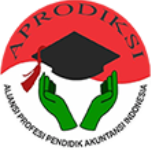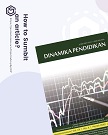Design of Augmented Reality Book for Economic Mathematics Course
(1) Universitas PGRI Semarang
(2) Universitas PGRI Semarang
Abstract
The type of this research is a development research that aims to produce android-based learning media using AR on a economic mathematic which is feasible to use and can easily know the results of students learning ability. The method used is ADDIE method which consists of 5 stages, namely Analysis, Design, Development, Implementation and Evaluation. Data analysis was done by normality test, homogeneity test, t test, and learning mastery test. The results of this study concluded that (1) the results for the percentage of media expert validation amounted to 89.2%, material experts 86.1% and learning design experts 87.5% with the criteria of each very good. (2) the result of practicality test based on student response obtained percentage equal to 88,9% with very good criterion. (3) data from the field show that the learning outcomes of students who obtain android-based learning media using AR better than students using learning by lecturing method (conventional learning).
Keywords
Full Text:
PDFReferences
Akbarini, N. R., Murtini, W., Rahmanto, A. N. (2018). The Development of Lectora Inspire-Based Interactive Learning on General Administration Subject. Dinamika Pendidikan, 13, 72–79.
Antonioli, M., Blake, C., & Sparks, K. (2014). Augmented reality applications in education. Journal of Technology Studies. Retrieved from https://doi.org/10.1109/IWADS.2000.880913
Azuma, R., Baillot, Y., Behringer, R., Feiner, S., Julier, S. and MacIntyre, B. (2014). Augmented reality applications in education. Journal of Technology Studies. Retrieved from https://doi.org/10.1109/IWADS.2000.880913
Bastos, R. and Dias, M. (2007). Efficient Texture Tracking using Optical Flow and Backprojection Information. In Proceedings 15th EPCG, Microsoft Portugal, Tagus Park, Porto Salvo (Best Paper Award).
Bastos, R. and Dias, M. (2008). Automatic Camera Pose Initialization, using Scale, Rotation and Luminance Invariant Natural Feature Tracking. Journal of WSCG, Vol.16, pp.97–104.
Billinghurst, M., Kato, H. and Poupyrev, I. (2001). The MagicBook—Moving Seamlessly between Reality and Virtuality, Computer Graphics and Applications. IEEE, Volume 21(Issue 3), pp. 6 – 8.
Buchori, A., & Yusuf Ilyas, M. (2014). Pengembangan Media Pembelajaran Matematika Berbasis Kocerin (Kotak Cerdas Interaktif) Dengan Menggunakan Model Discovery Learning di SMP. JIPM, 2, 17–29.
Buchori, A., Setyosari, P., Dasna, I. W., Ulfa, S., Degeng, I. N. S., & Sa’dijah, C. (2017). Effectiveness of Direct Instruction Learning Strategy Assisted by Mobile Augmented Reality and Achievement Motivation on Students Cognitive Learning Results. Asian Social Science. Retrieved from https://doi.org/10.5539/ass.v13n9p137
Budiman, H. (2017). Peran Teknologi Informasi Dan Komunikasi Dalam Pendidikan. Pendidikan Islam, 8, 75–83.
Dosi, G., Freeman, C., Nelson, R., Silverberg, G. and Soete, L. (1988). Technical Change and Economic Theory. London: Frances Pinter.
European Commission. (2003). Third European Report on Science and Technology Indicators. Luxembourg.
Hannafin, M., Land, S., & Oliver, K. (1999). Open learning environments: Foundations, methods, and models. Instructional-design theories and models: A new paradigm of instructional theory. Prentice Hall.
Howells, J. and Roberts, J. (2000). From Innovation Systems to Knowledge Systems. Promtheus, 18(1), 17–31.
Lundvall, B. (1992). National Systems of Innovation. London: Pinter.
McLellan, A. T., Woody, G. E., Metzger, D., McKay, J., Durell, J., Alterman, A. I., & O’Brien, C. P. (1996). Evaluating the effectiveness of addiction treatments: reasonable expectations, appropriate comparisons.
Mishra, S. and Sharma, R. (2004). Interactive Multimedia in Education and Training. Information Technology Newsletter, Indira Gandhi National Open University, 15(2), pp 27–28.
Mustaqim, I. (2016). Pemanfaatan Augmented Reality Sebagai Media Pembelajaran. Pendidikan Teknologi Dan Kejuruan, 13, 174–183.
Nincarean, D., Alia, M. B., Halim, N. D. A., & Rahman, M. H. A. (2013). Mobile Augmented Reality: The Potential for Education. Procedia - Social and Behavioral Sciences. Retrieved from https://doi.org/10.1016/j.sbspro.2013.10.385
Putri, Reni Sevia and Wardoyo, C. (2017). The Development of Financial Accounting Learning Tools with Gall and Borg Model. Dinamika Pendidikan, 12(2), 86–97. Retrieved from https://doi.org/10.15294/dp.v12i2.13559
Rost, M. (1994). Listening. London: Longman.
Saputro, R. E., & Saputra, D. I. S. (2014). Pengembangan Media Pembelajaran Mengenal Organ Pencernaan Manusia Menggunakan Teknologi Augmented Reality. STMIK AMIKOM Purwokerto.
Sari, W. S., Dewi, I. N., & Setiawan, A. (2012). Multimedia Presentasi Pembelajaran Berbasis Augmented Reality untuk Pengenalan Pancaindra dalam Mendukung Mata Pelajaran IPA Tingkat Sekolah Dasar. In Seminar Nasional Teknologi Informasi & Komunikasi Terapan.
Sari, A. S. (2017). Analisis Kemampuan Koneksi Matematika Siswa Pada Materi Teorema Pythagoras Ditinjau Dari Gaya Kognitif. Universitas Muhamadiyah Surakarta.
Sari, P. M. (2013). Perbedaan Hasil Belajar Menggunakan Metode Kooperatif Dengan Metode Ceramah Pada Mata Pelajaran Ekonomi. Pendidikan Ekonomi. Universitas Negeri Padang. Universitas Negeri Padang. Retrieved from Retrieved from http://ejournal.unp.ac.id/
Setyosari, P. (2012). Metode Penelitian Pendidikan dan Pengembangan. Jakarta: Kencana Prenada Media Group.
Shin Y. S. (2004). Virtual Experiment Environment’s Design for Science Education. International Journal of Distance Education Technologies (IJDET), 2(4), 62–76.
Sielhorst, T., Feuerstein, M., & Navab, N. (2008). Advanced medical displays: A literature review of augmented reality. Journal of Display Technology, 4(4), 451–467.
Stratford, S., Krajcik, J. and Soloway, E. (1998). Secondary students’ dynamic modeling processes: Analyzing reasoning about synthesizing and testing models of stream ecosystems. Journal of Science Education and Technology, 7(3), pp.215–234.
Sugiyono. (2015). Metode Penelitian dan Pengembangan. Bandung: Alfabeta.
Suharso, A., & Muhaimin, M. (2016). Media Belajar Kerangka Manusia 3D Berbasis Magicbook Augmented Reality (AR) (Studi Kasus SMPN 1 Kota Baru). UNSIKA Syntax Jurnal Informatika, 5, 1–15. Retrieved from https://journal.unsika.ac.id/index.php/syntax/article/view/697
Suparno, S. (2017). Development of E-Book Multimedia Model to Increase Critical Thinking of Senior High School Students. Dinamika Pendidikan, 12((2)), 111–121.
Vandergrift, L. (1999). Facilitating second language listening comprehension: acquiring successful strategies. ELT Journal, 53(3), pp.168–176.
Wilson, M. (2003). Discovery listening – improving perceptual processing. ELT Journal, 57(4), pp.335–343.
Wu, T. and Chao, H. (2008). Mobile e-Learning for Next Generation Communication Environment. International Journal of Distance Education Technologies (IJDET), 6(4), pp. 1–13.
Zhang, S., Chen, T., Zhang, Y., Hu, S. and Martin, R. (2009). Vectorizing Cartoon Animations, Transactions on Visualization and Computer Graphics. IEEE, July/Augus.
Refbacks
- There are currently no refbacks.

This work is licensed under a Creative Commons Attribution 4.0 International License.

.png)

.png)





